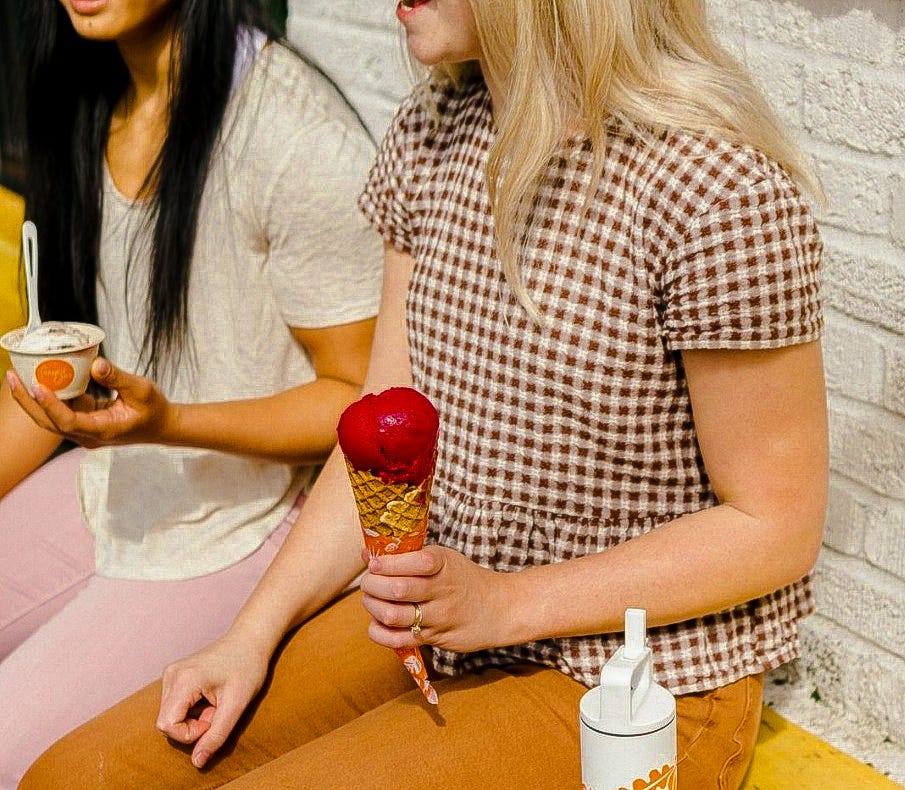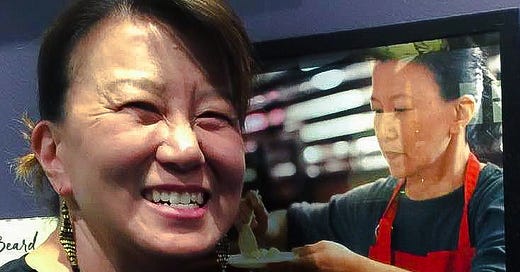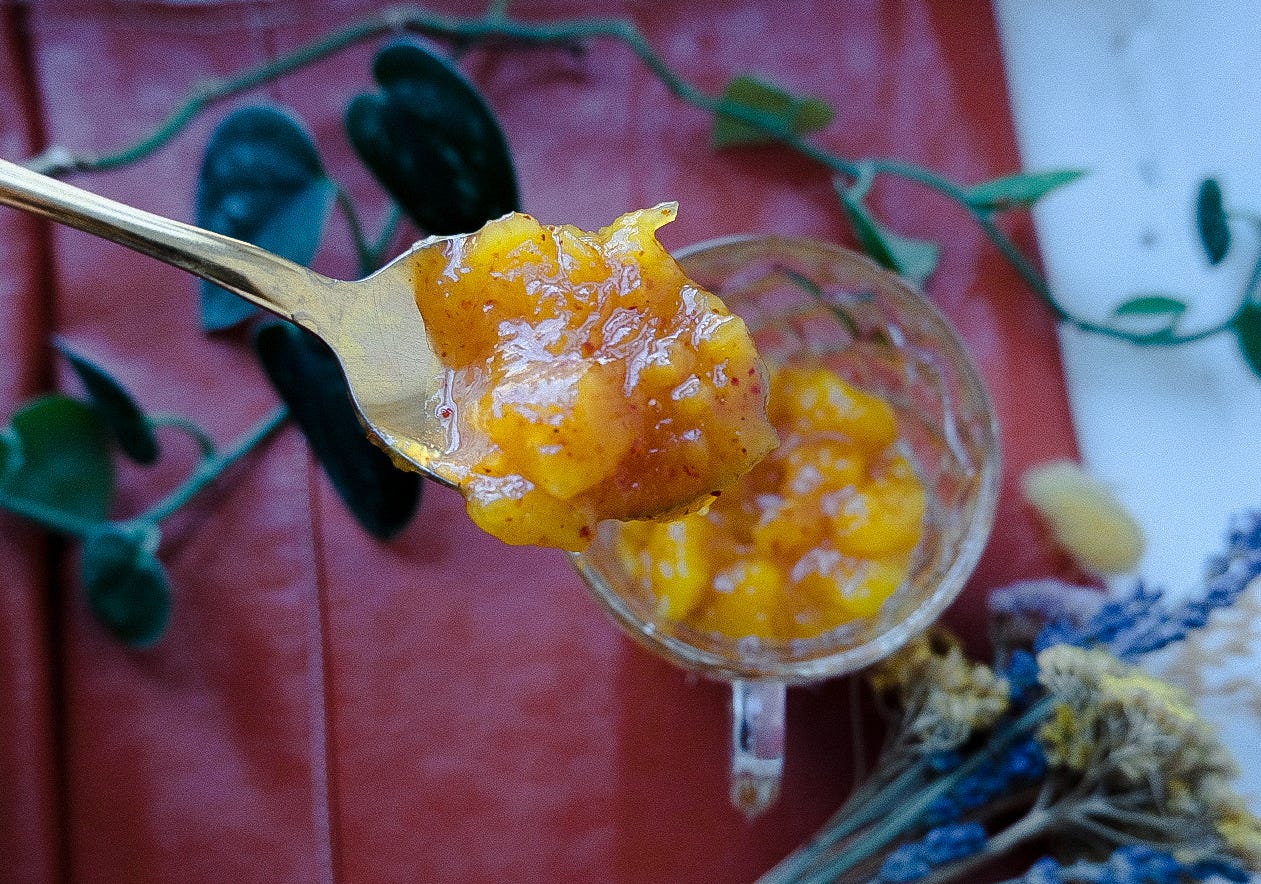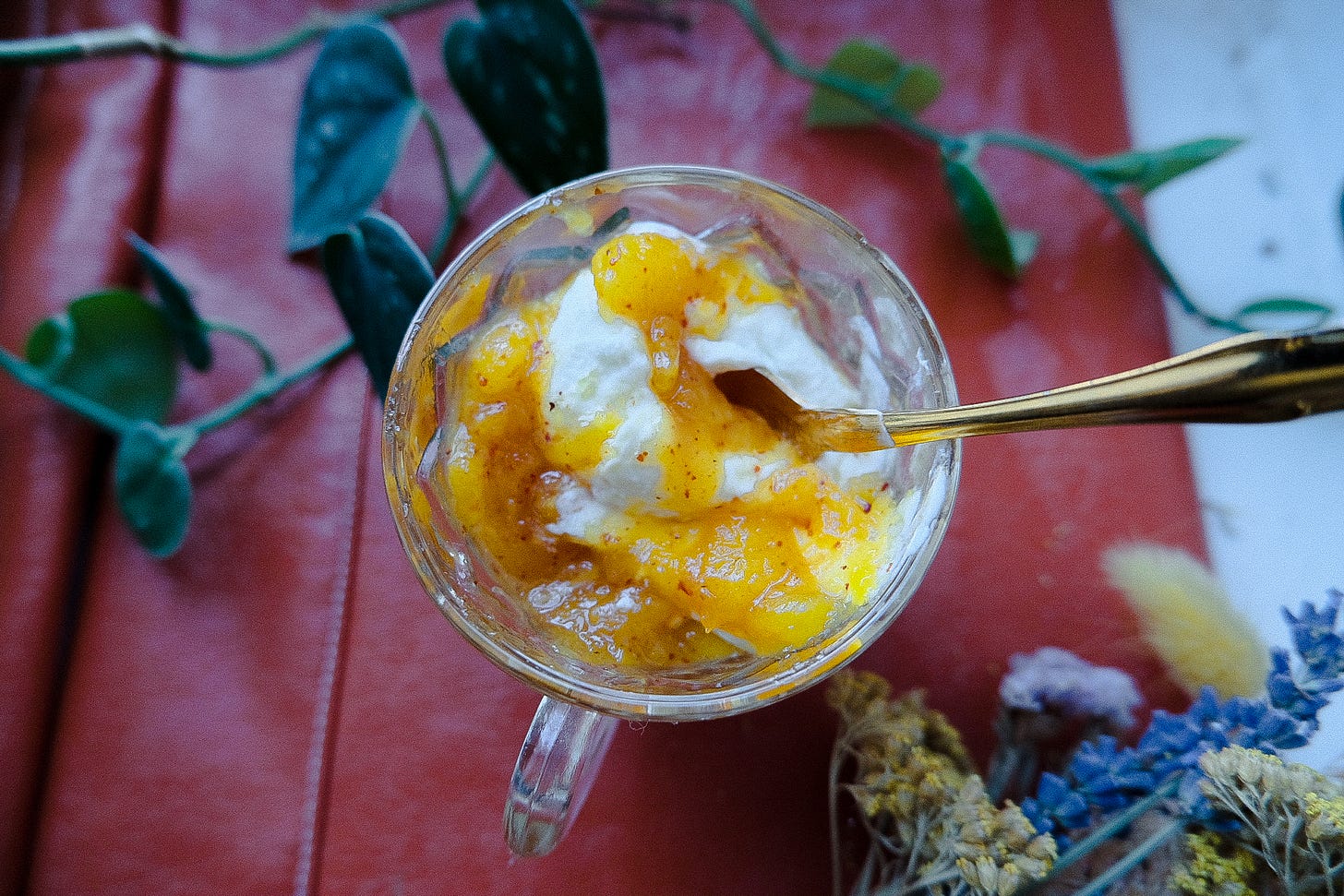From Fava Beans & Pig Ears, To Churning Out Vegan Ice Cream with Chef Lisa Nakamura - No. 14
And a simple mango compote inspired by our chat.
Welcome to Vegarie, where I interview vegetables and make dips out of women…wait something is off there. If you haven’t already, please subscribe (while it’s still free!) and you'll receive my biweekly newsletter on Tuesdays where I interview women in food—friends, family, home cooks, line cooks, restauranteurs, you name it—and include recipes for dips, spreads, and other accouterments that will absolutely tickle your tongue.
In this week's newsletter, my featured guest is Chef Lisa Nakamura. If you’re a Seattle native, you may already know of Lisa via one of her many culinary feats over the years. Maybe you stumbled upon her first restaurant, Allium, on Orcas Island, or tasted her legendary gnocchi at Gnocchi Bar in Capital Hill. No? Ok, it’s also possible that you whipped up her gnocchi at home during the pandemic. Or, hey, have you heard of that vegan ice cream shop, Frankie & Jo’s? Whatever it is, odds are, Lisa has entered your life already and she has such an interesting story. Together, we talk about the winding path from her first career flying with Delta Airlines, to owning her restaurants, and the many stops in between that brought her to where she is today. Most impactful to me, was her tip to “stop seeing life as having an ‘end goal,’ but to see it as a series of pit stops, the more fun, the better.” I gain so much each time I chat with Lisa, and I know you will too.
Lisa and I met through LinkedIn, funny enough, and we haven’t met in person—yet. Amid a personal career crisis this summer, I reached out to Lisa to learn more about what she did as the chef at Frankie and Jo’s, my absolute favorite ice cream shop. To be honest, I didn’t expect a response from a stranger. But what surprised me, even more, was her willingness to be vulnerable and open about her path, sharing tips that I could take not only into a culinary career but into life. That chat with Lisa this summer was ultimately why I’m writing my blog in general and reaching out to other women that I find inspiring. (Thank you, Lisa!)
Growing up in a small town near Hilo, Hawaii, Lisa’s family, especially her grandmother, loved to cook for special occasions.
“I made noodles and sushi with my grandmother. I still really struggle to capture the same flavors because that generation didn’t measure things the way we do. Nothing was weighed or measured in terms of cups or grams, it was a pinch of this, or—for example, the measurement for noodle soup was to add flour to the dough until it felt like an earlobe.”
The same rule was true with the way she—and I—learned to make rice. It doesn’t matter how much rice you’re using; you always fill the water to the height of your knuckle. “It’s rules like that that make you go, what the heck—everyone has a different size finger, how does that work? but it always does.” The hardest thing to recreate has been her grandmother’s futomaki, literally translated to mean, “fat rolled sushi,” in Japanese.
“It’s not the type of sushi you’d find at a sushi bar, it’s more like a peasant roll. Most Japanese food you find in Hawaii, it’s more countrified Japanese food than traditional. It’s a huge effort to make though, because it’s not just about getting the rice right, it’s about the taste…and it’s about all the rules. You have to have an even number of fillings, but you can’t use 4 of anything, because it’s the number that represents death in Japanese culture, so on.”
Outside of what she learned from her grandmother; cooking wasn’t a big part of her childhood. Lisa thinks a lot of this had to do with limited resources, “unless you grew up farming there, most of what you’d find at the grocery was expensive and imported. So, outside of things that grew on the island—like my favorite, mangoes! —there was a lot of canned meat.” Regardless, she describes her home as having a classic 70’s pantry, full of kraft singles, brown rice, carob, margarine, and ramen noodles. “I didn’t have real butter until I was in college. My mother would cut out half the sugar and most of the salt from recipes.”
The Winding Road to Food
Coming to the mainland for college at Arizona State University, where she studied botany, was a major shift for Lisa. She remembers landing on a 100-and-something degree day and wondering what she was doing there. However, what was more shocking than the weather? Thanksgiving.
“The first time I ever had a thanksgiving on the mainland, it was a bit disappointing because I was like, wait, where’s the rest of the food?”
Lisa’s Thanksgiving table in Hawaii was bountiful, “two tables end to end, full of food. Every year it was turkey, all the trimmings and sides, besides cranberry sauce, no one liked that for some reason, and then also sushi, potato salad, Lummi salmon, Chinese noodles.” With one year left of her degree, she realized she didn’t want to be a botanist. She became a flight attendant with Delta Airlines and moved to Georgia—you’ll find that moving somewhere new and throwing her system into shock is a big part of Lisa’s story. She ended up staying in the industry for almost nine years. That’s right, she had a whole career before she started cooking, so starting late IS possible.
“Flight attendants work around twelve days a month. So, when I wasn’t flying, I was cooking. I loved food and wine magazine and would throw dinner parties where I’d make all this fancy food—although I noticed people always liked the simplest stuff.”
With flying still in her back-belt, she dove forward into her passion for cooking and ended up in a catering kitchen. She loved it. From there, she attended culinary school in Maryland at L’Academie de Cuisine and continued on to work in Washington DC for a “classic-chaotic screaming French chef.” Regardless of feeling scared more often than not, after two years she had really earned her chops and took a leap, staging all the way in California at the French Laundry.
Working at the French Laundry
Not knowing what to expect in the first week staging at the French Laundry, she would get in around 5 AM and work until closing. “I mean, it was crazy…it was just, magical.” Six months later, she relocated and began as the first female cook at the French Laundry.
“When I was hired at the French Laundry, I was the first woman. I was the first woman to work the line. Now I look at his feed, and I see all these women in the kitchen. And I see Asian women in the kitchen. And I’m so fucking happy. It just makes me so happy to see that diversity.”
I’m sure you’re all wondering, what was it like to work with Thomas Keller? “There was no screaming, no Thomas didn’t scream. But it was even more intense because it wasn’t just about technique. It was about a mindset and a philosophy. It wasn’t just about roasting a beet. It was about learning where that beet came from, why we were harvesting at a certain time, what the best technique was to roast the beet, how you were going to serve it, and what to pair it with. Things that I don’t think a lot of cooks have the opportunity to think about.”
In other words, Thomas was all about the details and passed that knowledge down through the kitchen. Lisa remembers one of her lessons well because she’d made it through her long prep list, exhausted, she was getting ready to leave before realizing that she’d missed harvesting the fava beans.
“I didn’t think it was that big of a priority. As I was getting ready to leave, Thomas asked me if I had picked the fava beans, and I told him that I ran out of time. I remember him telling me, I never want to hear you say that you’ve run out of time. You have the pick the fava beans today because tomorrow they’ll be too starchy.”
She remembers long hours spent dissecting fava beans from their pod, then from the husk, and dicing the beans into fine brunoise, all before blanching. Now, if you’ve ever cooked fava beans, you know that most people will take the bean out of the pod, blanch it, and then remove it from the husk before even dealing with the bean because it’s just easier. Sort of like how baking a potato, allowing it to cool, and then slipping the skin off can be easier than peeling it while it’s raw if you don’t have a peeler. But not at the French Laundry. “Thomas knew that doing things this way was harder, but there was always a reason, a philosophy for how it would improve the result. Dicing and removing the bean from the husk before blanching, made the bean greener. Another example was the pig ears that were cooked and then passed along to me to dice into fine brunoise, as even as I could get with this gelatinous and thick thing. It was so difficult. But this is the way he wanted it done because the mouthfeel was different for him. It’s what he wanted.”
I asked Lisa what her personal life was like during this time. How she managed life in an intense kitchen like this and remained sane. The answer, well, she didn’t.
“I worked, I slept, I worked, I slept, I did laundry, I worked, I slept. It was like that for a while. It wasn’t until the pandemic, honestly, that I realized I shouldn’t work so much. That I should start focusing on my mental health.”
Owning A Restaurant
And owning a restaurant surely doesn’t help that balance. In fact, in this industry, it only makes things more hectic.
“I knew about numbers, like food cost, labor cost, but no one tells you about taxes, or about how you become HR, the plumber, the person that’s supposed to have all the answers. You do the best with the information you have, and hope that it’s good enough.”
After years of working as a chef abroad in Germany and South Korea, Lisa eventually made her way back to the states, where she opened her first restaurant, Allium on Orcas Island. If you’re not familiar with Washington or the greater Seattle area, you may not realize how remote Orcas is. Coming from Seattle, you’d need to drive around 90 minutes and take a ferry to find your way. Meaning that not only was she on the clock all day, but for the three years that Allium was open, there was also a major commute that separated her from seeing her husband. Seeing that the Orcas location couldn’t operate without her there every day, Lisa looked for a new venture in Seattle. One, she hoped, that would allow for a day or two off.
“The second restaurant I had, I made gnocchi. I started experimenting with various techniques, beginning with a recipe from the French Laundry. I had never actually made them there, they were sort of this holy grail, the gnocchi, and I didn’t want to mess them up.”
Gnocchi Bar was a big hit in Capital Hill, but she began wholesaling her gnocchi as well and found that was possibly a more successful route, offering a bigger work-life balance as well. When the rent came up for renewal, she decided to give up the space and stick with selling the gnocchi wholesale.
“We sold to around 40 groceries stores, and we also supplied some restaurants with gnocchi. We did it all by hand, so I’d show up to the kitchen space I rented with 300 pounds of potatoes in the trunk of my car. Our biggest client was Tutta Bella in Seattle, and during the pandemic, I decided to sell the recipe to Tutta Bella.”
Becoming Someone Else’s Chef
Each venture taught Lisa something different about the world of food. What she values most now though, she never would’ve expected. She says that taking the job at Frankie and Jo’s and becoming someone else’s chef, released her. It allowed her to enjoy life. To focus on becoming a more pleasant person, to herself and others, to spend more time with her husband, and with her friends. Also, “we do a lot of tasting ice cream, which doesn’t suck.” — Doesn’t suck?! Lisa, I know that’s an understatement. When I die, I picture heaven looking like me, swimming in a vat of Frankie and Jo’s ice cream. Sounds sticky and delicious. I’d be lying if I said I didn’t dream about that at least once a month.
“I approach ice cream in the same way I would a savory dish. I look for balance and punctuation. There has to be something that brings the main element to life, whether that’s doubling down, pairing it with something complimentary, or adding punctuation— like lemon or salt.” Her favorite flavors at Frankie and Jo’s have been some of the seasonal flavors, such as peaches and cream, passionfruit parfait, and pineapple upside-down cake. Of the permanent menu, she’s a sucker for the classic strawberry beet rose sorbet.

Outside of her love of ice cream, and anything chocolate, her favorite part of working at Frankie and Jo’s is mentoring the next generation of ice cream makers. “I like helping them not just to refine their skills in the kitchen, but how to manage things, how to approach different situations and be a better employee. Not only at Frankie and Jo’s but so that they can take those skills to their next job too.”
“I’ve been able to concentrate on things I’ve never been able to before. I wrote a little impetuous variation and published it on my 55th birthday, and now I keep aquariums and breed guppies, it’s things like that I never would have done if I still had a business. I never would’ve had the time.”
Released from the stresses of owning her own business, and still full of energy, Lisa has uncovered all kinds of hobbies. She keeps aquariums, writes, volunteers at animal shelters, and stays hungry for more experiences.
“I stopped thinking of life as ‘this is the end goal,’ or you must do this to get to that. Because there is no end goal. There are temporary stops along the way that you are aiming for, sure, but if the end goal is going to be anything, it should be who you have become as a person. If your end goal is something material, like I have to have a restaurant, well then, what happens when you reach that goal? What then? So, I like to think of life as full of pit stops. And make your pit stops really interesting. Then when you move on, and you will, that’s ok. Just make sure to take that knowledge and do something good with it.”
For Women in Food
Lisa says back when she was starting in the kitchen, she had to put up with a lot of nonsense that she shouldn’t have had to as a woman. As the adage says, she had to work a lot harder and retain a competitive edge a lot longer than the men did. “Hopefully that behavior is becoming less frequent in the kitchen. But my advice to you and all women; don’t be afraid to speak up. Don’t be afraid to take up space, you’re meant to be there just as much as anyone else. Don’t be so angry, I think I spent a lot of years being angry and I’m not sure if it was productive anger.”
We talked for a while about kitchen dynamics with other women as well. When the majority of cooks are men and the standard is set to present them with more responsibility, suddenly resources seem more dire for the women.
“Don’t be jealous of other women in the kitchen. Try to come from a place of, ‘there’s enough for everyone,’ rather than, ‘I need to get mine.’ I missed out on a lot of what could have been amazing relationships with other women because I was so competitive. Our world has conditioned women to live in this scarcity mindset, to think that there are only so many resources for us.”
“Some people don’t realize that sitting in your pajamas and eating snacks is such a luxury. Some days I just want to sit in my pajamas and eat Chex mix, because it feels good.”
When I asked Lisa what she’s excited about next, her answer made me smile. She says that her initial reaction is to say retirement but couldn’t possibly conceive of a world where she isn’t working.
“Sometimes I think about what my parents might think. Like you have all this training and skill and what are you doing with it? Are you wasting it? And I think to myself, well maybe I am. Would I want to open another restaurant? But no, I have all this energy at my age, and I just don’t want to use it on that. I like working on my next novel and volunteering at animal shelters. My friend and I are even working together on greeting cards because she’s an amazing artist.”
Lisa, I can’t possibly thank you enough for taking time from your busy schedule to chat about life and I hope that you know how inspiring your story is for other women. I promise to visit you in Seattle soon…one can only hope it will involve ice cream.
A Simple Mango Compote
Hearing about Lisa’s love for the mangoes she grew up eating in Hawaii made me crave them deeply. Unfortunately, it’s not quite mango season, and none of what we can find here in NYC will be quite as fresh, deep, or creamy as island mangoes. So! This mango compote will have to do until they start coming in a bit sweeter.
Ingredients
3 mangoes, diced (as ripe as you can find!)
1/3 c + 1 tbs honey (remember — I made this with sour mangoes, you can pair back on the honey, maybe to 1/4 c if yours are sweet)
1/4 c water
Tajin to taste — I did around 1 Tbs
Nutmeg (optional) - I also added a couple dashes of nutmeg. I loved how the nuttiness in this spice paired with the sourness of my fruit.
Instructions
Super simple. Over medium heat, add your diced mango, honey, and water to a small saucepan. Bring to a simmer.
Once the mixture begins to simmer, turn the heat down to low and leave for 5-10 minutes for the mango to break down and absorb some of the liquid.
The mixture should begin to thicken and have a jammy consistency. Cut the heat and add your nutmeg, tajin, and taste. Serve over yogurt, ice cream, pudding, or even spread on toast for a zingy breakfast.






